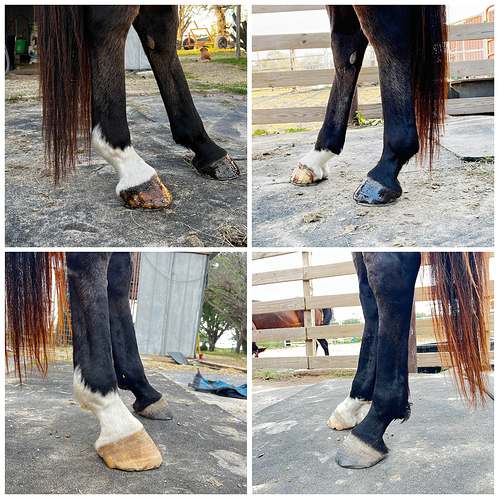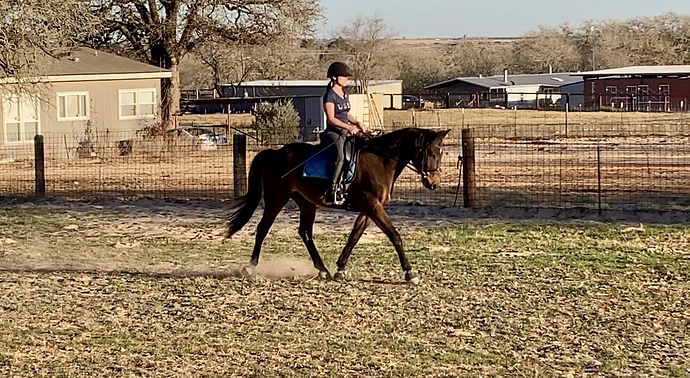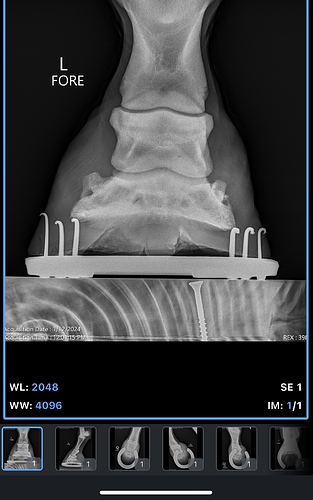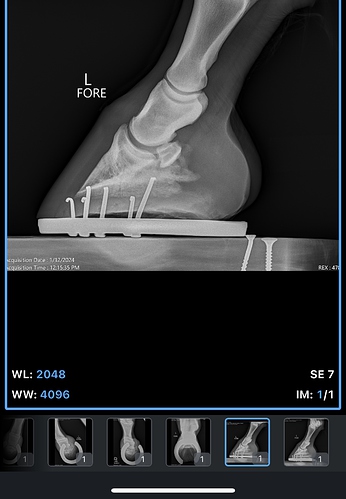My wife just said something I have never heard of. Gelding scars. So I googled it and omg…. Wouldn’t it be amazing if it were something so simple.
I always agreed that he needed to have a higher plantar angle and it’s been hard to find anyone like a vet or farrier to agree because per the xray it’s “fine” and it’s not negative. But considering the rest of the horse I don’t think you can just accept that since it’s not negative that it’s adequate.
When I compare his feet from today with his feet from October 3rd it doesn’t seem like his hoof composition changes too much but the angle of the cannon bone is perpendicular now to the ground. You can see in the October photos how the cannon bone is not perpendicular to the ground and it would be easy to say I took the picture crooked but I didn’t. I went into the photo app to manipulate the bottom pictures to have the cannon bone be perpendicular to the ground and you can imagine what it did to the angles in the hoof. 
He has taken a very positive turn for the better this week. Seeing him happy and workman like and not act out or get frustrated when he stumbles is incredible. I was having these thoughts today while cleaning stalls how backwards everything seems to be with him. I used to keep him turned out 24/7 because at shows and clinics he would lock up in his back and get super stiff which led to behavioral issues. Now I’m having to keep him confined and he’s having to learn how to be relaxed in spite of being stalled.
This is THE protocol that most vets use: Rehabilitation of Tendon and Ligament Injuries (seraonline.org)
Here is another of the original articles on PSD related to rehab protocol that vets rely on:
untitled (aaep.org)
Complete stall rest is no longer recommended except for the first few days. Controlled exercise is the norm.
We just got home from the vet, this was his third visit. They did a repeat ultrasound on both of his hind suspensories and there was no change from the previous ultrasound in October. So at least what we’re doing in our rehab plan isn’t hurting that part of him.
I still received no answers about his back pain that I feel like he has. He is totally nonreactive on his physical examination. The can flex his pelvis any way they want to and he does it just fine. They flexed his rib cage and he was fine. At a stand still he is fine.
I cannot manufacture what he does under saddle at the vet, but even when he’s not under saddle anyone would agree that he looked irritated. During his straight line jog he would swish his tail, throw his head, and pin his ears. The plaiting was no longer apparent today. The lameness locator says he’s sound on a straight line. When I ride him in a straight line he is hollow to the right and bulges out of his left shoulder. He cannot hold himself up in a straight line for very long.
I’m kicking myself for not getting footage of his left circle, when I tell you it was so bad… it looked like he had two different trots front and back, I’m sure it wasn’t even true to the gait if someone really analyzed it. It looked like he was falling out in front of himself while also falling out behind himself. He was really struggling. Then after they blocked the front left foot because they graded it 2/5 (it’s always been 2/5 on his lameness exams) it seemed to get better but they really had to chase him to even get him to move so I don’t really call that a win even if it wasn’t as bad as his last circle train wreck.
We are up to 15 minutes of trot and 45 minutes of walk daily, and he is in a small paddock. Some days he is forward, other days he has a death march and it’s so much work to keep him going. His only forward button is one that goes UP. He usually televises by pinning his ears, then he will swish his tail, then he will throw his head, and then he will buck or spook. Depending on the day and if the stars have aligned or not, he will spook or buck out of nowhere without the previous warning signs (one so bad I fell off at the walk on the buckle, I’m sure this story is in here already). Other days he goes incredibly well. On his mediocre days there are times he will give me a beautiful elastic well balanced trot, but he can’t hold it very long and sometimes there is this sudden tension that completely makes him fall right back apart, and this is painful - not strictly from weakness. He is very reactive to pain, he is not stoic. In October he was grade 3/5 in his right hind yet 3 days before his diagnosis we had a beautiful dressage lesson and most people would have never guessed that he had lameness issues! Pretty Dressage Lesson 
They did imaging of his front left and he still has a medial lateral imbalance and there is a 23 degree difference with the lateral portion having greater height than the inside. He was reset on Wednesday and the shoe is placed more medial to support it and encourage it to grow out that direction. When he was barefoot he had lateral flares and crushed medial aspect (not crushed like NPA, he is actually really upright in the front feet, he grows heel faster than toe in the front). Farrier admittedly took more heel on Wednesday to account for that and with these new images it most likely altered the PA to be less ideal, the good news is he grows heel like crazy so it will be an easy fix of just waiting a few weeks. It’s not negative in the palmar angle but not ideal. Vet suggested to inject the coffin joint despite beautiful joint spacing because she is hypothesizing that his soft tissue is sore in the hoof and xray won’t account for that. We discussed different options and I chose not to inject his coffin joint. If our goal is to eliminate pain to see if there is improvement then I’d rather a cheaper, less invasive, and more encompassing modality be used such as previcox or bute. That way, if there really is something in his body or back that hurts him, he can have pain relief and anti inflammatory for that and also help whatever pain is in his front left foot. We’re going to do a loading dose of previcox and if there is no change after 2 weeks then we will do a 2 week trial of bute. I know it’s called equiox or something I just can’t stop calling it previcox.
He’s going next Thursday on another 3 hour drive to a different vet in Navasota to be evaluated for gelding scars. I know that’s an unconventional thing and maybe fringe to a lot of vets, but I really am desperate here. I just want him to get better. I want him to live up to his full potential. I don’t want to believe that this is a primary case of PSD from poor conformation. Everything is telling me that both of these things are secondary to whatever is going on in the lumbosacral region. I know he stood camped under for 6-9 months while we figured this out. I know that could have been enough to inflame the suspensory. If you go by the idea that lameness appears in diagonal pairs and his right hind is the lamest leg then it makes sense that his front left would also be affected.
After reading so many stories about gelding scars, and how easy they are to fix even if it requires surgery… I would holler from the roof tops if this was the root cause of all his issues. From his right pelvis always being shifted forward and asymmetric, to him resting his right hind with his hock pointed in towards his belly with his toe facing out, to being hollow on the right, not being able to poop and walk at the same time (maybe that means nothing) - it all fits him to a T.
The vet remarked that this might be a matter of heart, grit, resilience, personality. As if his signs of pain are really just nothing at all and not rooted in pain. She asked me if I took him to a trainer, to see if this is a training issue and I explained he was professionally started and he’s well educated and I’ve been working with him a lot with my 2 coaches. When I momentarily did think about sending him to a “cowboy” (because by then I had been gaslit to hell and back about how I just need to sell him to someone with young horse experience) the cowboy even remarked how there was something wrong in his right hind, higher up in the limb. Plus, the good days that we HAVE had tell me that he has the capacity to be happy and workman like in his work. When he is in pain he is a totally different horse. It’s really hard for me to believe that all this could just be mental. What if he really did have a physical issue and I just carried on and quit looking and he was in pain forever? What if there as a physical issue and he was euthanized when it could have been fixed? If the other vet determines there are no castration adhesions internally, I will continue the rehab plan with his teaching hospital vet, if he still isn’t improved after 6 months I will turn him out for a year and try again later. If he still can’t be brought back into work I will have to consider different actions, but as of now in his current state I wouldn’t sell him. I don’t want someone else in a dangerous situation. I don’t want him to be inadvertently abused as someone else tries to make him work when he physically can’t. He can’t take a joke. He dies at the thought of going into a forest clearing. I’m hoping it doesn’t ever come to that bridge and we can get to the bottom of this. Which is why I share here, for awareness of the weird condition I had never heard of until now, and maybe someone else has gone through what I have and can maybe share what worked for them.
Following your story and very curious about the gelding scar question and if that is part of the problem.
I know many on here are big proponents of veterinary teaching hospitals, but do you have a good sports medicine vet close to you? They tend to have excellent trained eyes for the smallest details about how a horse travels or carries themselves and what it may indicate. I just didn’t have as good of an experience in terms of identifying lameness issues at the hospital as I did with sorts med vet.
Stifles are a higher up area in the hind that often presents similar to SI and could probably cause same symptoms as gelding scars. He could have compensated stifles from the original issue and they way he moved and stood. It may be worth a look with a fresh set of eyes. Sometimes the same vets get fixated and can’t see what they can’t see.
Keep us updated.
I had a vet who also had a gelding scar case. We talked about it as potentially relevant to my horse’s pain and behavior. Certainly not impossible but one of those “zebra” issues. Took exploratory surgery in the case the vet knew of to figure out.
But based on conformation and movement of your horse, I think the SI joints could be a significant issue. I do see the wonkiness with the RH/LF diagonal. SI was one of the major problems with my horse. All the diagnostics we could do while living were pretty normal. His necropsy showed significant pathology, however.
Having just watched some of the dressage video my first thought is PSSM. His action and unsteadiness in the bridle are such strong indicators. I think at this point you wouldn’t lose much having him tested, and trying the PSSM2 diet and exercise recommendations.
The other thing to consider is that the horse is just not healed yet despite ultrasound findings. Maybe some time off and the Equioxx will do him more good than anything.
He may have been moving better on that arena footing than on the harder ground at home. He looked really nice in the video.
I would attribute that to my error more than his. On that day it was the first time we cantered after he was off for 7 weeks from a wall resection of the front left. He might have been back to work 3 weeks by then only trotting. I would say this video of our show last June would be indicative of us at our peak fitness. June Show
He has always been managed as you would a pssm horse and etalon tested him negative for pssm 1 but I know muscle biopsy is the gold standard. I will text his managing vet on Monday to see what she says. I will agree that he has some symptoms and the pain does correlate with work and he’s never reactive at a stand still. He also doesn’t sweat as much as he should. He does sweat but you think it would be more. Did the Elissa Wallace clinic in July, XC at 4pm and I wasn’t happy with his minimal sweat, everyone just said he was acclimated and not working that hard but I disagree.
He had a loading dose of previcox last night and he is much less reactive today during our ride. He’s the type to get upset if he trips, and he’s not tripping today. I can actually hear him touch his own shoes so maybe his pelvis is working better. This is all just so he can complete his rehab in one piece and be productive with it instead of locking up in his back and hurting the both of us.
You say he’s been diagnosed by ultrasound and re ultrasounded with no improvement .I’m not sure what you’re trying to achieve riding this horse at trot and canter and looking for alternative explanations? PSD doesn’t heal in 3 months ,rehab takes longer than this and even then doesn’t always work.
Believe it and act accordingly or your horse will continue to be lame ime.
According to what my vet says, there will never be improvement in the ultrasounds. You can only assess to see that they’re not getting worse. And they’re not. Also, I’m not cantering. She said we are still at least 2 months out from cantering. I’m not doing anything currently that isn’t prescribed by the vet that is managing this case.
Perhaps I should have bolded this part of that sentence
“I don’t want to believe that this is a primary case of PSD from poor conformation”
That means I think this is secondary to something else. There is no way that a horse that has been judged at least 12 different times by several different people from USEA wouldn’t notice a horse that had hocks that were “too straight.” Not only that but winning, multiple times, for conformation, having an article written about his conformation where they say his body should be able to excel at the upper levels of eventing - etc.
It almost feels like there has been zero intervention at all. They said his left suspensory had evidence of PSD and that it healed despite being ridden for 2 years. He still goes around acting unhappy and grumpy. I can tell when he doesn’t hurt because he is a totally different horse. I know it’s in there. The good days we have had where he isn’t fighting his body tells me there has to be something else. Not instead of - but in addition to. I’m not going to be one of those people that just accepts that horses are “bad” because of their personality or lack of heart.
Especially when I read studies like this
“ It is sometimes considered erroneously that
horses with straight hocks are predisposed to suspen-sory disease. Biomechanically, the pathophysiology of this syndrome follows this sequence: a degenerative suspensory disease induces a fetlock suspension defect; hyperextension of the fetlock increases tension on the SDF tendon, which pulls the tuber calcanei cranially and induces secondarily hyperextension of the hock.
Therefore, a straight hock conformation is not a predisposing factor to suspensory disease but is just the result of an existing elongation of the suspensory ligament.”
I would 100% be retiring/euthanizing if he isn’t comfortable out to pasture. I’d fear the only outcome would be tens of thousands more spent to still be in the same place. You’ve done so much already. Have you x rayed the back and neck? Just thinking of kissing spine and ecvm.
On the other hand, this case really intrigues me as it reminds me of one of my previous horses that we had to put down and never did really find out what was wrong. Following your story closely and so appreciate you sharing!
Do you have a short description of a pssm 2 diet/exercise recommendations? I keep hearing this but I can’t find the actual recommendations. Just curious!
He is completely normal in his physical exam and not reactive to anything so therefore his spine, SI, lumbosacral area MUST be fine under these static conditions. Therefore they won’t do imaging of his back. I go there asking for a more detailed assessment of his back and leave with them wanting to inject his coffin joint in the left front. 
According to the lameness locator my horse is sound trotting in a straight line on hard ground. Never mind the fact he completely falls apart and looks terribly lame on a trotted circle. He’s definitely pasture sound. Shoot, he’s riding sound, you just have to be able to feel when he’s about to have had enough and stop before then. If I get no answers and complete this rehab per the vet instructions and still don’t get anywhere then I will turn him out to pasture for a year and try again later. If that doesn’t work I’ll be thinking about euthanasia.
I’m sorry, but to me, that’s not riding sound or really sound to me at all.
Also, I don’t know if I didn’t read this correctly (wouldn’t be a first for me!) but he’s had no imaging of his back at all?
If you’re going to the vet wanting diagnostics (that are not invasive), and they’re telling you no, it’s time to find a new vet.
Apply for membership to this FB group: https://www.facebook.com/groups/pssmandmimawareness
You’ll learn a lot very quickly. Although the Equiseq testing for PSSM2 is not peer-reviewed it can be very helpful when sorting out diet. For the most part you need protein, not too much fat (that’s PSSM1), and daily forced exercise. Turnout, even in large areas, is not enough. “Forced” exercise can be as little as 15 minutes per day on the longe, but the aim should be for 5 - 7 days per week. When we started with the gelding who came to me for training and we got a handle on his problem, the most he could tolerate without pain was about 5 minutes of walk in hand 4x/day. We consulted a nutritionist to help to manage his diet, most feed companies can provide that service, and ours was local to BC, and we gradually built up the exercise over the course of a month. At the end of the first month he was a totally different horse. I learned an awful lot about PSSM2 along the way!
When I started to suspect PSSM2 as the problem we contacted a sports med DVM, who was quite sure that it was a training issue. He came out to the farm, and did an extensive workup, all of it negative for any kind of skeletal, tendinous, ligamentous issue(s), and he flexed and x-rayed clean: at the end of it we pulled a hair sample to send to UC Davis for PSSM1 testing (horse was an unregistered Appendix QH), and the vet was convinced that he had PSSM2. We did the Equiseq testing and the results indicated the P2 and PX variants, which helped us to tweak his diet.
The diagnosing vet said it was the first horse he’d seen with very clear indications of PSSM2, and certainly both the owner and I felt quite confident after the change in the horse resulting from the dietary/exercise changes. We’d been trying to take it easy on him, and working him every second day, with a recovery day in between, which was just about the worst thing for him.
I agree with this.
Yes and I’m going for a third opinion on Thursday. He’s going to be assessed for gelding scars but they’re a sports medicine vet so I will be able to get a third opinion. Because this current vet was the second opinion.
The first vet said he was fine and he wasn’t lame enough to warrant nerve blocking and just blamed it on thin soles in the front feet even though you could trot him down an asphalt road and he would be just fine.





